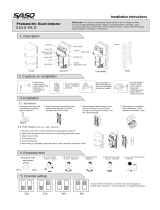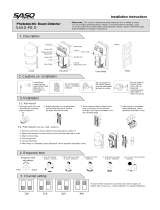Page is loading ...

LS2030
/
LS2060
/
LS2080
/
LS21200
Photoelectric Beam Detector
Installation Instructions (UK) ................................ 11
Détecteurs infrarouges actifs
Instructions d’installation (F) ................................. 19
Actief infrarood detector
Installatieshandleiding (NL) .................................. 28
Laserstråle detektor
Installationsvejledning (DK) .................................. 36
Dual-Infrarot-Lichtschranke
Installationsanleitung

11
1. Preface
Dear Customer,
thank you for purchasing this photoelectric beam detector. This equipment is
produced with state-of-the-art technology, which complies with the current
standards of domestic and European regulations. The CE has been proven and all
related certifications are available from the manufacturer (www.security-center.org)
upon request.
To ensure proper and safe operation, it is your obligation to observe these
installation instructions!
In the event of questions, please contact your local specialist dealer.
2. General advice
To reduce the risk of electric shock and to ensure that your guarantee remains
valid, do not open the equipment when it is in use.
No part of the product may be changed or modified in any way.
The photoelctric beam must only be used within the prescribed temperature and
protection class ranges. Using the equipment outside the prescribed ranges results
in greater wear and early failure. All required specifications can be found in the
technical data.
Avoid greater physical stress of the equipment (knocks, vibrations, etc.). Incorrect
handling and bad transport conditions can lead to damage to the equipment.
We want you to work only with products that incorporate state-of-the-art technology.
For this reason, we reserve the right to make technical modifications.
We reserve the right to make changes to these instructions without prior notice.
© ABUS Security-Center GmbH & Co. KG, February 2010
LS2030/LS2060/LS2080/LS21200
Photoelectric Beam Detector
Installation Instructions

12
3. Main features
• Long detection range
• Reliable detection through pulsed dual beams
• Easy and quick installation through horizontal and vertical angle alignment
of transmitter and receiver
• Adjustment by laser beam, LED and measurement of the voltage level
• Adjustable response time (50 ms – 700 ms)
• Relay switching (NC/NO) and LED indication while activated
• Waterproof (IP55) and temperature-resistant for outdoor installations
• Applications: Alarm systems, video supervision, lighting, etc.
(e.g.: doors, entrance halls, car parks, halls, fence systems)
• Tamper monitoring of transmitter and receiver by front tamper switch
4. Scope of delivery
• Infrared transmitter (Tx) with front cover, housing screw and mounting
plate with self-tapping screw
• Infrared receiver (Rx) with front cover, housing screw and mounting plate
with self-tapping screw
Accessories for mast mounting:
• 2 x mounting plates
• 2 x mounting brackets
• 6 x roundhead screws M4x10
• 4 x roundhead screws M4x20
5. Description of components
5.1 Transmitter (Tx) and receiver (Rx)
Transmitter (Tx) Receiver (Rx)
1. Connectors
2. Power LED
3. Screw for vertical alignment
4. Horizontal alignment
5. Lenses
1. Connectors
2. Alarm LED
3. Signal LED
4. Potentiometer knob for adjusting
response time

13
6. Laser beam for alignment
7. Switch for laser beam
5. Tamper contact
6. Contacts for measuring voltage
level
7. Screw for vertical alignment
8. Horizontal alignment
9. Lenses
10. Laser beam for alignment
11. Switch for laser beam
5.2 Description of connectors
Transmitter (Tx): Receiver (Rx):
1/2 Voltage supply 10-30 V DC
3/4 NC Tamper output
1/2 Voltage supply 10-30 V DC
3 COM alarm contact
4 NC alarm contact
5 NO alarm contact
6/7 NC Tamper output
6. Installation
6.1 Important notes
• Remove all obstacles (plants, washing lines and other objects) between
the transmitter and the receiver.
• Avoid direct light or sunshine on the transmitter and receiver.
• Avoid installation where dirt and water can fall directly on the transmitter
and receiver.
• Install the transmitter and receiver on a stable, vibration-free surface.
• Avoid positioning so that the beams reflect on surfaces or objects.
• Reduce the recommended range if there is a high probability of mist or
similar unfavourable weather conditions.

14
6.2 Position of transmitter and receiver
The recommended installation height for transmitter and receiver is between 0.70 m
and 1 m. Both components can be adjusted horizontally (+/-90°) and vertically (+/-
15°). This permits flexible installation in the most varied physical conditions (see
examples A, B and C).
6.3 Detection range
When installing the photoelctric beams, note the detection range (L) and radiation
range (X) of the transmitter.
Model Detection range L (Outdoo
r
s) Spread of beams
X
LS2030 30 m 0.9 m
LS2060 60 m 1.8 m
LS2080 80 m 2.4 m
LS2120 120 m 3.6 m

15
6.4 Wall mounting
1. Remove the front cover of the transmitter and receiver by undoing the
housing screw.
2. Loosen the base-plates by undoing the fixing screw and remove it
3. You now have two ways of fixing the connection cable to the rear side.
a.) Guide the connection cable through the cable guide on the base-plate.
b.) Guide the connection cable through the cable guide of the detector. To
do this, remove the predetermined breaking point from the rear of the
detector to guide the connection cable through.
4. Now break out the opening for the cable guides on the rear of the
transmitter and receiver and connect the cables to the correct connectors.
5. Screw the base-plates to the desired installation locations.
6. Screw the transmitter and receiver to the nase-plates.
7. After connecting the cables to the connectors, go to the “Putting into
operation” section.
6.5 Pole mounting
1. Use a pole with a diameter of 38-45 mm.
2. Remove the screwed base-plates of the transmitter and receiver.
3. Screw 2 screws M4x20 into the screw-threads of the mounting brackets.
4. Fix the mounting brackets to the masts.

16
5. Screw the mounting plate with 3 screws M4x10 tightly to the base-plates of
the transmitter and receiver.
6. Fix the mounting plates to the mounting brackets.
7. Repeat steps 3–7 of “Wall mounting”.
7. Putting into operation
Before aligning the photoelctric beam, connect the power supply.
You can also connect up the alarm and tamper lines after alignment.
7.1 Rough alignment with laser and LED
Important:
Never look directly into the laser beam! The laser used has a power of
<= 5 mW at a wavelength of 650 nm and belongs to Class 3a (classification
according to DIN VDI 0837).
1. Switch on the laser switch of the transmitter.
2. Align the transmitter horizontally and vertically so that the laser beam
points to the centre of the receiver. Alignment is optimal when both LEDs
of the receiver stop lighting.
3. To check: repeat steps 1 and 2 with the laser on the receiver.
The LED on the receiver gives you a first indication of the strength of the received
signal.
Alarm LED (red) and signal LED (yellow) Signal strength
Both LEDs OFF Optimal
One LED ON Adjust
Both LEDs ON Realign
7.2 Fine adjustment by voltage measurement
1. When the transmitter and the receiver are firmly mounted at the installation
location, you can make the fine adjustment of the photoelctric beam by
measuring the voltage level.
2. Switch your measuring device to the setting “DC” and select the lowest
voltage range (0-10 V DC).
3. Measure the voltage on the receiver and compare the value with the table
below.

17
4. Now adjust the horizontal angle of the receiver by hand until the measuring
device shows the highest value.
5. Turn the adjusting screw to adjust the vertical angle of the receiver until the
measuring device shows the highest value.
6. Compare the voltage with the values below.
7. After achieving a good alignment quality, do not realign the transmitter or
receiver again.
V
oltage level Quality of alignment
5 V – 3.4 V Optimal
3.4 V – 1.15 V Good
1.15 V – 1.0 V Sufficient
< 1.0 V Readjust
7.3 Adjusting the response time
By turning the potentiometer on the receiver, you can change the response time
(default 300 ms) of both light beans until an alarm is detected. If the actual
response time is shorter than the set response time, no alarm is triggered.
7.4 Putting into operation
1. Now close the transmitter and receiver with the front covers.
2. Carry out a walk test. Take the response time you set into consideration.
3. If required, readjust the Receiver and repeat the walk test.
8. Troubleshooting
Fault Possible reasons Remedy
Power LED on
transmitter (Tx) or
receiver (Rx) does not
light
Incorrectly connected or
no power
Check the voltage supply
at the connectors
Alarm LED (Rx) does not
light when the
photoelctric beam is
interrupted
– No power
– Tx and Rx incorrectly
aligned
– The photoelctric beams
were not interrupted
simultaneously
– Check the voltage
supply
– Clean the front cover
– Check the wiring
Photoelctric beams are
boken and the alarm
LED (Rx) lights, but no
alarm is triggered
– Wrong or missing
connection of alarm
contacts
– Relay defect due to
over-voltage
Check the connections of
the alarm contacts
Alarm LED (Rx) lights
permanently
– Tx and Rx incorrectly
aligned
– Photoelctric beam is
interrupted
– Front cover is dirty or
covered in ice
– Realign Tx and Rx
– Remove all obstacles
between Tx and Rx
– Clean the front cover

18
False triggering of
photoelctric beam by
leaves, animals, etc.
– Tx and Rx badly
aligned
– Response tune set too
low
– Unfavourable
environmental influences
at installation location
– Realign Tx and Rx
– Change the installation
location
9. Technical data
Detection type
Active infrared photoelctric beam (dual pulsed beams)
Max. detection range
Type LS2030 LS2060 LS2080 LS2120
Outdoors
30 m 60 m 80 m 120 m
Indoors
60 m 120 m 160 m 240 m
Supply voltage
10 V-30 V DC (without polarity)
Power consumption
Type LS2030 LS2060 LS2080 LS2120
Tx+Rx
65 mA 69 mA 73 mA 77 mA
Response
/
interruption
time
Adjustable: 50 ms – 700 ms
Alarm output (Rx)
Relay (NO/NC) 1 A / 120 V AC
Tamper output (Tx+Rx)
NC contact 1 A / 120 V AC
LED signalling Power LED (green: Tx+Rx): Voltage supply connected
to transmitter (Tx) and receiver (Rx)
Alarm LED (red; Rx): Bad alignment or interrupted
photoelctric beam
Signal LED (yellow; Rx): Weak IR ray or interrupted
photoelctric beam
Max. external light
strength for frontal
irradiation
Light sources < 10000 Lux
Sunshine < 30000 Lux
Lase
r
Wavelength 650 nm; power <= 5 mW; Laser class 3a
(classification according to DIN VDI 0837)
Ambient operating
temperature
-25°C to 55°C
Protection class
IP55
Dimensions
173x74x72 mm (hxbxd)
/


